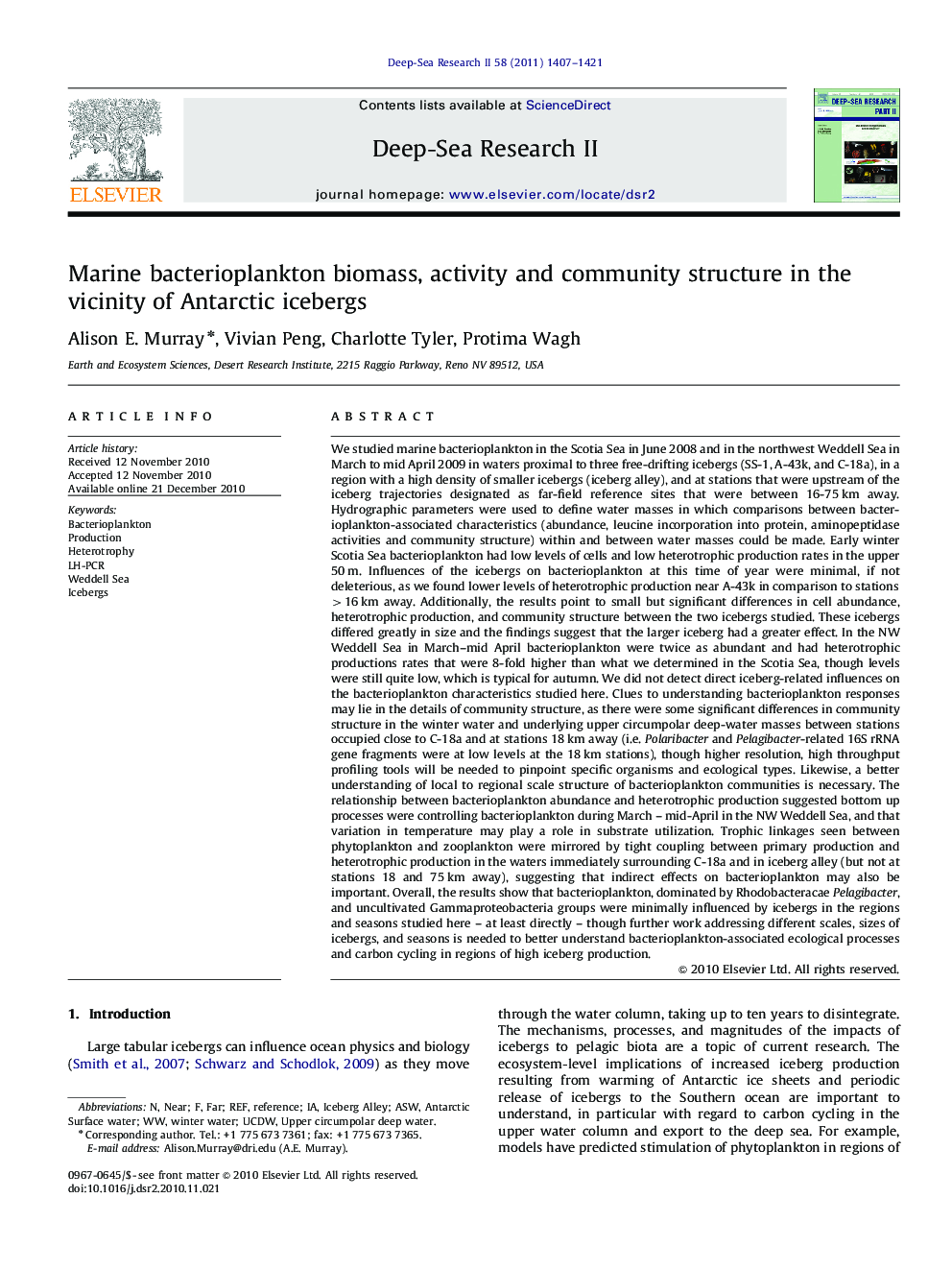| کد مقاله | کد نشریه | سال انتشار | مقاله انگلیسی | نسخه تمام متن |
|---|---|---|---|---|
| 4536874 | 1626465 | 2011 | 15 صفحه PDF | دانلود رایگان |

We studied marine bacterioplankton in the Scotia Sea in June 2008 and in the northwest Weddell Sea in March to mid April 2009 in waters proximal to three free-drifting icebergs (SS-1, A-43k, and C-18a), in a region with a high density of smaller icebergs (iceberg alley), and at stations that were upstream of the iceberg trajectories designated as far-field reference sites that were between 16-75 km away. Hydrographic parameters were used to define water masses in which comparisons between bacterioplankton-associated characteristics (abundance, leucine incorporation into protein, aminopeptidase activities and community structure) within and between water masses could be made. Early winter Scotia Sea bacterioplankton had low levels of cells and low heterotrophic production rates in the upper 50 m. Influences of the icebergs on bacterioplankton at this time of year were minimal, if not deleterious, as we found lower levels of heterotrophic production near A-43k in comparison to stations >16 km away. Additionally, the results point to small but significant differences in cell abundance, heterotrophic production, and community structure between the two icebergs studied. These icebergs differed greatly in size and the findings suggest that the larger iceberg had a greater effect. In the NW Weddell Sea in March–mid April bacterioplankton were twice as abundant and had heterotrophic productions rates that were 8-fold higher than what we determined in the Scotia Sea, though levels were still quite low, which is typical for autumn. We did not detect direct iceberg-related influences on the bacterioplankton characteristics studied here. Clues to understanding bacterioplankton responses may lie in the details of community structure, as there were some significant differences in community structure in the winter water and underlying upper circumpolar deep-water masses between stations occupied close to C-18a and at stations 18 km away (i.e. Polaribacter and Pelagibacter-related 16S rRNA gene fragments were at low levels at the 18 km stations), though higher resolution, high throughput profiling tools will be needed to pinpoint specific organisms and ecological types. Likewise, a better understanding of local to regional scale structure of bacterioplankton communities is necessary. The relationship between bacterioplankton abundance and heterotrophic production suggested bottom up processes were controlling bacterioplankton during March – mid-April in the NW Weddell Sea, and that variation in temperature may play a role in substrate utilization. Trophic linkages seen between phytoplankton and zooplankton were mirrored by tight coupling between primary production and heterotrophic production in the waters immediately surrounding C-18a and in iceberg alley (but not at stations 18 and 75 km away), suggesting that indirect effects on bacterioplankton may also be important. Overall, the results show that bacterioplankton, dominated by Rhodobacteracae Pelagibacter, and uncultivated Gammaproteobacteria groups were minimally influenced by icebergs in the regions and seasons studied here – at least directly – though further work addressing different scales, sizes of icebergs, and seasons is needed to better understand bacterioplankton-associated ecological processes and carbon cycling in regions of high iceberg production.
Journal: Deep Sea Research Part II: Topical Studies in Oceanography - Volume 58, Issues 11–12, June 2011, Pages 1407–1421